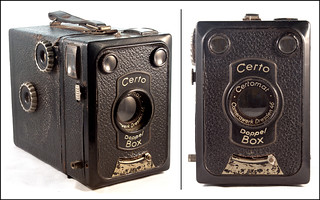Difference between revisions of "Certo Doppel Box"
Hanskerensky (talk | contribs) |
Hanskerensky (talk | contribs) m |
||
| (13 intermediate revisions by the same user not shown) | |||
| Line 1: | Line 1: | ||
| − | |||
{{Flickr_image | {{Flickr_image | ||
|image_source= https://www.flickr.com/photos/inspiredphotosdotcom/4810564739/in/pool-camerawiki/ | |image_source= https://www.flickr.com/photos/inspiredphotosdotcom/4810564739/in/pool-camerawiki/ | ||
| Line 8: | Line 7: | ||
|image_rights= with permission | |image_rights= with permission | ||
}} | }} | ||
| − | The '''Doppel Box''' was made in Germany by [[Certo]] c.1935<ref>Confirmation needed as also 1932 is mentioned in the literature.</ref>. | + | The '''Doppel Box''' was made in Germany by [[Certo]] c.1935<ref>By Kadlubek. Confirmation needed as also 1932 is mentioned in the literature (McKeown).</ref>. |
| − | It is called '''Doppel''', German for '''Double''', because it can shoot 2 formats, eight 6x9cm images or | + | It is called '''Doppel''', German for '''Double''', because it can shoot 2 formats, eight 6x9cm images or sixteen images 4.5x6cm on [[120 film|120 roll film]]. It has a sheet metal body. The format can be selected by a knob on the right-hand side. The front section of the camera, containing the lens, shutter and finders, hinges away from the back to allow the film-holder insert to be removed for loading. |
| − | The | ||
| + | The control below the lens sets 3 (fixed) aperture sizes of f11, f16 or f22.<ref name=ME>[https://www.mikeeckman.com/2017/09/certo-doppel-box-1935/ Certo Doppel Box review] at [https://www.mikeeckman.com/ Mike Eckman]</ref> | ||
| + | |||
| + | The shutter has 'M' (Moment), 'B' (Ball) and 'T' (Timed) settings.<ref name=ME/> | ||
| + | |||
| + | The Certomat 1:11 / 10.5cm lens is of the doublet type. The lens has a fixed focus but there is a built-in portrait lens which can be swung in front of the Certomat and is for the distance range from 2 till 5 meters.<ref name=ME/> | ||
| + | |||
| + | It has 2 [[brilliant finder|brilliant viewfinders]]. One for the horizontal (landscape) and one for the vertical (portrait) orientation. Both have lines to indicate the 4.5x6cm format area.<ref name=ME/> | ||
| + | |||
| + | Film transport is performed manually by a winder key on the right-hand side. The back has 3 [[red window|red windows]] to observe the frame numbers, a big one for the 6x9cm format and 2 smaller ones for the 4.5x6cm format.<ref name=ME/> | ||
| + | |||
| + | {{Flickr_image | ||
| + | |image_source= https://www.flickr.com/photos/rareblues/4801945976/in/pool-camerawiki/ | ||
| + | |image= https://live.staticflickr.com/4114/4801945976_bc1916783d_n.jpg | ||
| + | |image_align= left | ||
| + | |image_text= Certo Doppel Box | ||
| + | |image_by= Wim Koopman | ||
| + | |image_rights= with permission | ||
| + | }} | ||
{{br}} | {{br}} | ||
Revision as of 05:17, 9 June 2020

|
| Certo Doppel Box image by Inspiredphotos (Image rights) |
The Doppel Box was made in Germany by Certo c.1935[1].
It is called Doppel, German for Double, because it can shoot 2 formats, eight 6x9cm images or sixteen images 4.5x6cm on 120 roll film. It has a sheet metal body. The format can be selected by a knob on the right-hand side. The front section of the camera, containing the lens, shutter and finders, hinges away from the back to allow the film-holder insert to be removed for loading.
The control below the lens sets 3 (fixed) aperture sizes of f11, f16 or f22.[2]
The shutter has 'M' (Moment), 'B' (Ball) and 'T' (Timed) settings.[2]
The Certomat 1:11 / 10.5cm lens is of the doublet type. The lens has a fixed focus but there is a built-in portrait lens which can be swung in front of the Certomat and is for the distance range from 2 till 5 meters.[2]
It has 2 brilliant viewfinders. One for the horizontal (landscape) and one for the vertical (portrait) orientation. Both have lines to indicate the 4.5x6cm format area.[2]
Film transport is performed manually by a winder key on the right-hand side. The back has 3 red windows to observe the frame numbers, a big one for the 6x9cm format and 2 smaller ones for the 4.5x6cm format.[2]

|
| Certo Doppel Box image by Wim Koopman (Image rights) |
Notes
- ↑ By Kadlubek. Confirmation needed as also 1932 is mentioned in the literature (McKeown).
- ↑ 2.0 2.1 2.2 2.3 2.4 Certo Doppel Box review at Mike Eckman